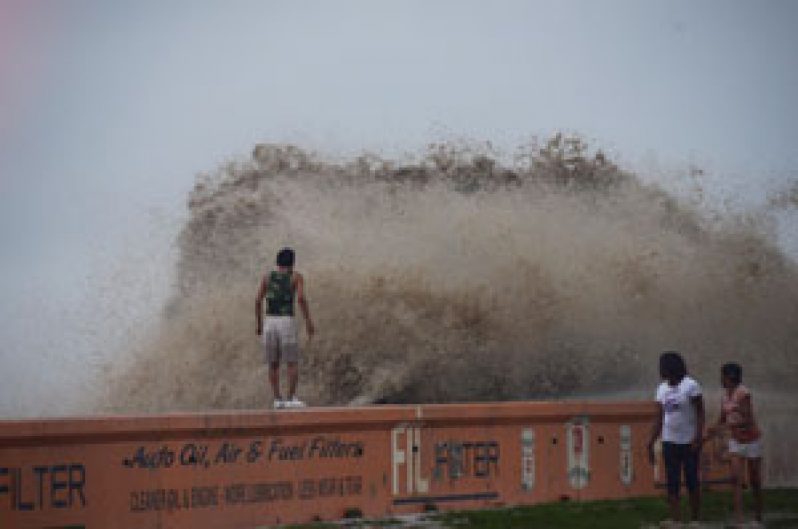THE people living along the coast of Guyana are under serious threat as a result of climate change-induced sea level rise.
 And, among the responses being considered, is a proposal to relocate them, according to the presentations made at a panel discussion last Tuesday evening at Cara Lodge, in Quamina Street, Georgetown.
And, among the responses being considered, is a proposal to relocate them, according to the presentations made at a panel discussion last Tuesday evening at Cara Lodge, in Quamina Street, Georgetown.
One of the propositions was put forward by Reverend Dr. Pedro Walpole, who founded the Environmental Science for Social Change Center based at the Ateneo de Manila University in the Philippines.
He posited that 90 percent of the country’s population live on its 370 kilometres long coastline that is 1.3 metres below high tide sea level and Guyana has emerged as a leading global advocate for developmental assistance to poor countries to make them more climate change resilient.
Walpole, who lives in an indigenous community in the Mindanao Province of The Philippines, cautioned that any relocation initiative must ensure livelihoods for those persons affected.
“Most of the relocation sites that I am seeing in the Asia-Pacific are consisting of anything from 50 to 500 houses, but there is no incorporation of livelihood space(s) for people to work,” he observed.
Also addressing the audience, which comprised of engineers, university students and environmental advocates, was local businessman, Mr. Stanley Ming.
He said: “Even those countries that have the engineering capacity and financial resources are taking decisions to move away from the coast.”
COST EFFECTIVE
Ming pointed out that, in England an entire coastal township in the South-East was moved many miles inland and, in the United States (U.S.), a decision was taken to abandon a number of islands, in the Aleutian Chain off Alaska, because it was recognised that moving the population was a more cost effective measure than building structures to fortify the islands against rising sea levels.
He said Guyana had already prepared similar plans and the Governments of this country and Germany had cooperated on a Natural Resources Management Project to draft a developmental scheme for a pilot area to be used for the purpose and it was presented in 2003.
Ming said the land identified for development starts at Lanaballi, some 40 kilometres inland and encompasses a contiguous section that measures 4,800 square kilometres and includes parts of Administrative Regions 3, 4, 7 and 10.
Confirming the suitability of the place for development, he cited the observation in the report that mining the sand, from the banks which had built up in the Essequibo River over many years, would yield millions of tons of material which could be utilised in construction.
Ming cited the proximity of the Teperu and St. Mary’s quarries, as well, to the proposed pilot site.
“All of the stone that we use for constructing sea defences, buildings and other infrastructure in Guyana comes from those two areas,” he informed.
Ming cited, too, the nearness of the quarries and logging sites that would reduce the cost of transporting materials for building.
Another resource in the surroundings, which is conducive to development, is water he said.
WATER FLOW
Alluding to the water flow at the juncture of the Cuyuni and Mazaruni rivers, Ming said: “If you had a three feet diameter pipe sucking that water out and if you were processing it, we would not have a need for wells in that entire area.”
Furthermore, he said the water being processed could be channelled through a pipeline spawning the Demerara River and piped through the existing infrastructure to meet citizens’ needs, thereby making the usage of wells unnecessary.
Ming went on to mention the agricultural and tourism potential of the targeted place.
The discussion was arranged by the Guyana Human Rights Association (GHRA), in collaboration with the East Coast Clean-up Committee (ECCC).





.jpg)








